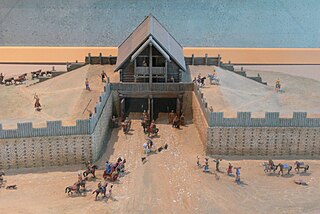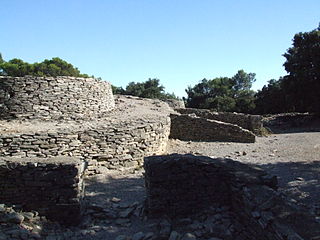
Ambrussum is a Roman archaeological site in Villetelle, Occitania, Southern France.

An oppidum is a large fortified Iron Age settlement or town. Oppida are primarily associated with the Celtic late La Tène culture, emerging during the 2nd and 1st centuries BC, spread across Europe, stretching from Britain and Iberia in the west to the edge of the Hungarian plain in the east. These settlements continued to be used until the Romans conquered Southern and Western Europe. Many subsequently became Roman-era towns and cities, whilst others were abandoned. In regions north of the rivers Danube and Rhine, such as most of Germania, where the populations remained independent from Rome, oppida continued to be used into the 1st century AD.

The Oppidum d'Ensérune is an ancient hill-town near the village of Nissan-lez-Ensérune, France, located between Béziers and Narbonne close to the D609 and Canal du Midi. It has been listed since 1935 as a monument historique by the French Ministry of Culture.
Canton of Marseille – Saint-Mauront is a former canton located within the commune of Marseille in the Bouches-du-Rhône department of France. It was created 27 February 2003 by the decree 2003-156 of that date. It was disbanded following the French canton reorganisation which came into effect in March 2015. Its population was 47,076 in 2012.
Canton of Marseille-Verduron is a former canton located within the commune of Marseille in the Bouches-du-Rhône department of France. It was created 27 February 2003 by the decree 2003-156 of that date. It was disbanded following the French canton reorganisation which came into effect in March 2015. Its population was 37,750 in 2012.
Canton of Marseille – Notre-Dame-Limite is a former canton located within the commune of Marseille in the Bouches-du-Rhône department of France. It was created on 27 February 2003 by decree 2003-156 of that date. It was disbanded following the French canton reorganisation which came into effect in March 2015. Its population was 35,163 in 2012.

Luzech is a commune in the Lot department in south-western France.

The Malpas tunnel carries the Canal du Midi under the d'Ensérune hill in Hérault, France. Excavated in 1679, it was Europe's first navigable canal tunnel and is a monument to the determination of Pierre-Paul Riquet, the chief engineer. It is located in the commune of Nissan-lez-Ensérune near to the archaeological site Oppidum d'Ensérune.

Châteaumeillant is a commune in the Cher department in the Centre-Val de Loire region of France.

Corent is a commune in the Puy-de-Dôme department in Auvergne-Rhône-Alpes in central France.

Bibrax is a Gallic oppidum. Its position has long been debated, but the oppidum is now almost certainly identified with the site of Saint-Thomas (Aisne).

The Fort de Brégançon is a medieval fortress that is located 35 metres (115 ft) above sea level on an island off the French Riviera. The island is connected by a short causeway to the mainland in the commune of Bormes-les-Mimosas in the Var department in the Provence-Alpes-Côte d'Azur region.

The Oppidum d’Altimurium, also known as the Oppidum Murviel-les-Montpellier, is an ancient hill-town near the village of Murviel-lès-Montpellier, France, located between Montpellier and Béziers. It has been listed since 1896 as a monument historique by the French Ministry of Culture.
Pech Maho oppidum is located in the town of Sigean, Aude, France. The last season of excavations on the archaeological site since 2004 has identified most of the walls and the habitats of a pre-Roman oppidum, particularly highlighting the latter stages of occupation of this site before its definitive abandonment.

The Oppidum de Nages or Oppidum des Castels is on a hilltop overlooking the valley called the Vaunage, above the village of Nages-et-Solorgues, in Gard, between Nîmes et Sommières, in Occitanie, France. It is one of six iron-age oppida in the Vaunage, occupied between 800 BCE and 50 BCE. It has been listed since 1980 as a monument historique by the French Ministry of Culture.

The Oppidum de Roque de Viou is on a hilltop overlooking the valley called the Vaunage, above the village of Nages-et-Solorgues, in Gard, between Nîmes et Sommières, in Occitanie, France. It is in the commune of Saint-Dionizy and is one of six Iron Age oppida in the Vaunage; about 200m from the Oppidum de Nages or Oppidum des Castels. It was occupied in three periods between 700 BCE and 600 BCE and between 350 BCE and 300 BCE and around 50 BCE. It has been listed since 1980 as a monument historique by the French Ministry of Culture.

Entremont is a 3.5-hectare (8.6-acre) archaeological site three kilometres from Aix-en-Provence at the extreme south of the Puyricard plateau. In antiquity, the oppidum at Entremont was the capital of the Celtic-Ligurian confederation of Salyes. It was settled between 180 and 170 B.C., somewhat later than the inhabitation of other oppida, such as Saint-Blaise. The site was abandoned when it was taken by the Romans in 123 B.C. and replaced by Aquae Sextiae, a new Roman city founded at the foot of the plateau. By 90 B.C., the former oppidum was completely uninhabited.

The Rue de Charenton is a historic street in the 12th arrondissement of Paris, France. Several buildings along the street have been listed as official historical monuments by the French Ministry of Culture, namely numbers 23-25, number 35, numbers 49-51, numbers 59-61, and number 85 bis.

The Gergovie Monument or Memorial to Vercingetorix is a monument by the Clermontois architect Jean Teillard built in 1900 on the eastern edge of the Gergovie plateau, a few kilometers south of Clermont-Ferrand in the French departement of Puy-de-Dôme in Auvergne. It commemorates Vercingetorix's victory over Julius Caesar on this site in 52 BC.















